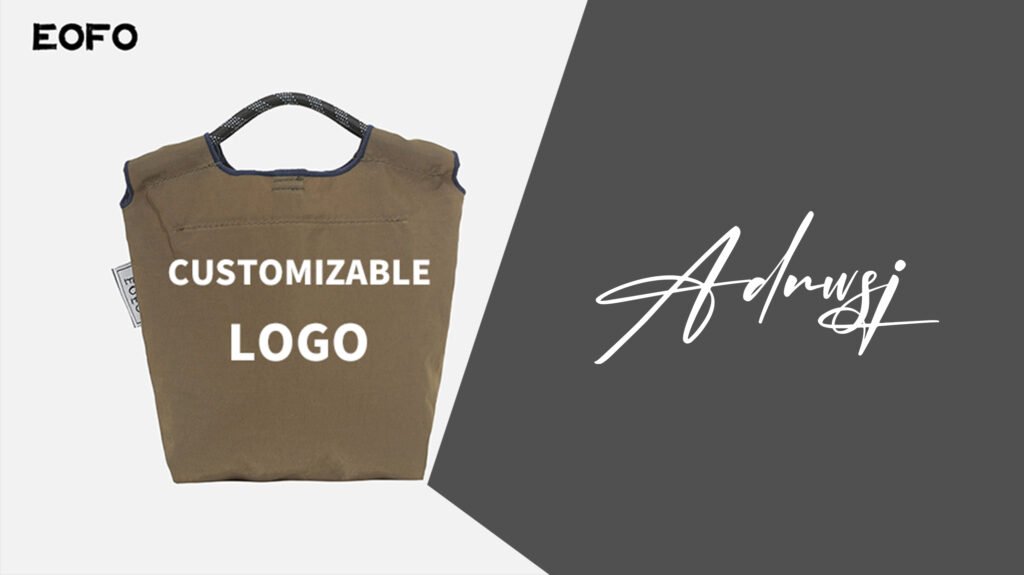Introduction
In today’s world, where environmental concerns are escalating and consumers are increasingly driven by values, the importance of sustainability in business operations cannot be overstated. Every action a company takes is scrutinized through the lens of environmental impact, creating a powerful incentive for businesses to align their practices with the principles of eco-friendliness. This shift towards sustainable business models is not just a trend—it’s an evolving paradigm that reshapes industries and consumer behaviors globally.
The purpose of this article is to explore how custom eco-friendly bags emerge as a pivotal tool in this green revolution, serving a dual purpose of effective branding and sustainable practice. Customized to reflect a company’s ethos and aesthetic, these bags not only amplify a brand’s visibility but also manifest its commitment to environmental stewardship. They are more than just carriers of goods; they are carriers of a message, a declaration of a brand’s dedication to a healthier planet.
By integrating custom eco-friendly bags into their branding strategy, businesses can leverage a potent combination of practical utility and public statement, ensuring that every product purchased and every bag carried extends their brand’s reach while underscoring their commitment to sustainability. This article delves into the myriad benefits that these eco-friendly solutions offer, not just to the businesses that adopt them, but also to the consumers and communities they touch. Let us explore how custom eco-friendly bags can transform mere transactions into opportunities for advocacy, positioning brands at the forefront of the sustainable movement.
Importance of Sustainability in Business
As businesses navigate the shifting landscapes of consumer expectations and regulatory environments, the imperative for sustainability has never been clearer. Adopting sustainable practices is no longer just about corporate responsibility; it is a strategic imperative that can define a brand’s identity and market success.
Consumer Preferences: Shifting Towards Green Choices
Recent trends and studies consistently demonstrate a significant shift in consumer preferences towards eco-friendly businesses. According to a global survey conducted by Nielsen, over 73% of surveyed consumers reported a willingness to change their consumption habits to reduce environmental impact. Furthermore, a Forbes study highlighted that products with sustainability claims generally outperform the growth rate of total products in their respective categories. Consumers are increasingly looking to support and purchase from brands that demonstrate commitment to environmental stewardship. By aligning with these preferences, businesses not only cater to a growing market demand but also foster customer loyalty and trust.
Regulatory Benefits: Navigating the Green Compliance Advantage
On the regulatory front, governments worldwide are tightening environmental regulations and setting more stringent compliance standards to promote sustainability. Businesses that proactively adopt green practices can benefit from various incentives such as tax reductions, subsidies, and improved operational permissions. For instance, in the European Union, the Eco-Management and Audit Scheme (EMAS) allows companies that improve their environmental performance beyond legal requirements to gain recognition and credibility. These regulatory benefits not only help reduce operational costs but also shield companies from the risks of non-compliance, which can include penalties and damage to reputation.
Brand Image Enhancement: Crafting a Sustainable Identity
Incorporating sustainability into business operations significantly enhances a brand’s image. A commitment to sustainable practices reflects a brand’s dedication to future generations and its responsibility towards the planet, which resonates deeply with today’s ethically-minded consumers. Brands that are perceived as responsible are more likely to receive positive media coverage, attract quality partnerships, and gain favor with stakeholders. This enhanced brand image can effectively differentiate a company in a competitive market, making sustainability a powerful element of the brand’s identity and value proposition.
Advantages of Custom Eco-Friendly Bags
In the realm of sustainable business practices, custom eco-friendly bags stand out as a beacon of innovation and environmental stewardship. These bags are not just functional; they are a statement. Here, we explore the multifaceted advantages they offer to businesses keen on aligning themselves with modern consumer preferences, regulatory frameworks, and a commitment to enhancing brand image through sustainability.
Consumer Preferences: A Market Driven by Green Choices
Recent statistics paint a clear picture: consumers are gravitating towards eco-friendly products. A study by Cone Communications found that nearly 87% of consumers would purchase a product because a company advocated for an issue they cared about. This trend is especially pronounced in the retail sector, where the demand for sustainable packaging is booming. Custom eco-friendly bags meet these demands head-on, offering businesses an opportunity to connect with this growing demographic. These products not only meet consumer expectations but also encourage a shift in consumer behavior, promoting reusable over disposable options.
Regulatory Benefits: Staying Ahead of Compliance
Globally, governments are stepping up environmental regulations, pushing companies towards more sustainable practices. In regions like the European Union, stringent guidelines on single-use plastics provide a regulatory impetus for adopting alternatives like eco-friendly bags. Companies using these sustainable solutions often benefit from incentives such as tax reductions, rebates, and a smoother path through regulatory landscapes. Moreover, by proactively adopting these practices, businesses can avoid future costs associated with adjusting to upcoming regulations, positioning themselves as leaders in compliance and innovation.
Brand Image Enhancement: Sustainability as a Brand Pillar
The impact of sustainability on brand image cannot be overstated. Incorporating eco-friendly practices, such as using custom eco-friendly bags, significantly boosts a brand’s reputation. Consumers today are not just interested in what a product does but also how it reaches them. A brand that demonstrates concern for the environment through sustainable practices is seen as more trustworthy and forward-thinking. This enhanced perception can lead to increased customer loyalty, higher rates of customer acquisition, and even premium pricing opportunities. Brands that are perceived as environmentally friendly often enjoy greater media attention, positive word of mouth, and a stronger emotional connection with their customers.
Conclusion: Strategic and Ethical Benefits Combined
The advantages of custom eco-friendly bags extend far beyond the basic utility of carrying goods. They are a powerful tool for businesses to align with consumer preferences, stay ahead of regulatory curves, and significantly enhance their brand image. By integrating these sustainable options into their operations, businesses not only adhere to a growing ethical standard but also leverage these practices for strategic advantage. In the competitive landscape today, custom eco-friendly bags offer a clear path to differentiation and long-term consumer engagement, marking them as an essential component of modern business strategy.
Types of Eco-Friendly Materials for Bags
In the pursuit of sustainability, the materials used in product manufacturing take center stage, especially when it comes to items like bags that are part of our daily lives. Let’s explore the innovative materials that are paving the way for eco-friendly bags, offering not only environmental benefits but also practicality and style.
Recycled Plastics: Turning Waste into Fabric
Recycled plastics are revolutionizing the way we think about waste. The process begins with the collection of plastic waste, which includes items like bottles, containers, and even garments. These plastics are then cleaned and sorted based on their type and color. Once sorted, the plastic is shredded into small flakes, which are melted and extruded into fibers. These fibers are then spun into yarns that can be woven or knitted into fabrics. This transformation from hard plastic to soft fabric is not only a testament to recycling technology but also a significant step towards reducing the plastic waste that clogs our landfills and oceans. Bags made from recycled plastic fabrics are durable, water-resistant, and, most importantly, kind to the planet.
Organic Cotton: A Softer Approach to Sustainability
Organic cotton offers a cleaner, more sustainable alternative to conventional cotton, which is often criticized for its heavy use of pesticides and water. Organic cotton is grown without synthetic chemicals and uses far less water, relying instead on natural processes that enhance soil quality and biodiversity. The benefits extend beyond environmental impact. Organic cotton fibers are free from harsh chemicals, making them softer, safer, and less likely to cause allergic reactions. This makes organic cotton ideal for bags that are not only eco-friendly but also offer a touch of natural luxury and comfort.
Hemp and Other Materials: Diverse and Sustainable Choices
Beyond recycled plastics and organic cotton, other materials like hemp, jute, and bamboo are making significant inroads in the eco-friendly bag market. Hemp is a robust material known for its durability and mildew resistance, making it ideal for tote bags and backpacks. It grows quickly, requires little water, and improves the soil it’s planted in. Jute, often referred to as the ‘golden fiber’, is another sustainable option, biodegradable and comes from a plant that absorbs large amounts of CO2. Bamboo, known for its rapid growth and ability to thrive without pesticides, is turned into a versatile fabric that is soft, breathable, and antibacterial.
Customization Options for Maximum Impact
In the competitive world of business, customization is key to differentiation When it comes to eco-friendly bags, the ability to tailor both the function and the aesthetics to align with a brand’s identity not only enhances visibility but also cements a company’s commitment to sustainability Here, we explore the impactful customization options that combine eco-friendliness with effective branding strategies
Printing Techniques: Eco-friendly and Brand Friendly
The choice of printing technique plays a pivotal role in both the environmental footprint and the visual appeal of custom bags Here are some eco-friendly printing methods that ensure vibrant results while keeping ecological impact to a minimum:
Water-Based Inks: Unlike traditional petroleum-based inks, water-based inks are less toxic and produce fewer volatile organic compounds (VOCs), making them a safer choice for both the environment and the workers in the printing facilities
Soy or Vegetable-Based Inks: These inks offer a renewable source that doesn’t compromise on quality They provide bright, clear colors and are easier to de-ink, which is beneficial during the recycling process
Digital Printing: Ideal for detailed and multi-colored designs, digital printing uses less ink overall and reduces waste compared to conventional printing techniques It’s highly efficient for small to medium-sized runs, reducing excess production
Design Tips: Crafting Impactful Visuals
Designing an eco-friendly bag that communicates a brand’s message effectively involves more than just aesthetic appeal; it’s about making a statement Here are some tips to ensure that your design makes an impact:
Simplicity is Key: A clean, simple design often stands out more than a busy one Use clear and concise messaging paired with bold graphics that reflect the brand’s ethos
Functionality Meets Style: Consider the shape and size of the bag A well-designed bag that is useful in everyday scenarios, like grocery shopping or at a gym, ensures more frequent use, thereby increasing brand exposure
Color Matters: Choose colors that not only attract the eye but also align with the brand’s identity Colors have the power to evoke emotions; select hues that convey your brand’s personality
Case Studies: Success Stories of Custom Eco-Friendly Bags
To illustrate the effectiveness of these customization options, let’s examine some successful implementations by other businesses:
A Retail Giant’s Shift to Sustainability: A well-known retail brand transitioned from disposable plastic bags to custom organic cotton totes with their vibrant logo printed using soy-based inks The bags became a customer favorite, doubling as a fashion statement and boosting the brand’s image as a leader in sustainability
Coffee Shop Chain Goes Green: A national coffee chain introduced hemp coffee bags with digitally printed designs highlighting their commitment to fair trade coffee These bags have not only been popular among customers but have also been featured in eco-conscious lifestyle blogs, further amplifying their brand reach
Fitness Studio’s Functional Designs: A fitness studio designed multi-purpose jute bags with minimalistic water-based prints The bags are used for carrying gym gear, which has increased visibility across various gyms and health clubs
Customization Options for Maximum Impact
In today’s market, customization is more than a luxury—it’s a strategic necessity. For businesses looking to enhance both their sustainability credentials and brand visibility, custom eco-friendly bags offer a compelling opportunity. Adopting eco-friendly printing techniques supports environmental goals and caters to increasing consumer demand for sustainable products. Innovative printing methods that combine eco-consciousness with effective branding include water-based inks, which are popular for their low environmental impact and lack of harmful chemicals, and soy-based inks, made from soybeans, which provide vivid colors and better ink coverage compared to traditional inks. Digital printing is also highlighted for its adaptability and less wasteful approach, suitable for short runs and on-demand printing.
Designing your eco-friendly bags with clarity and simplicity creates a stronger impression, utilizing clear, legible typography and meaningful imagery that resonates with your brand’s values. Functional aesthetics should consider the bag’s practical use, focusing on size, shape, and durability. Additionally, color psychology plays a critical role; utilizing colors that align with your brand identity and the message you want to convey can significantly influence consumer perception and behavior.
Learning from successful case studies can also provide valuable insights. For example, a prominent online fashion store introduced a line of custom-printed tote bags made from recycled materials that helped rejuvenate their brand image due to their eco-friendly impact and stylish design. A regional grocery chain replaced their single-use plastic bags with reusable hemp bags featuring seasonally updated designs, promoting repeated use and keeping the brand top-of-mind. Furthermore, a tech company distributed custom organic cotton drawstring bags filled with sustainable goodies at a major industry conference, enhancing their corporate image among clients and partners through demonstrated commitment to sustainability.
Through thoughtful customization of eco-friendly bags, businesses can significantly enhance their brand impact and alignment with sustainability goals. By choosing the right materials, employing green printing technologies, and designing with the consumer in mind, companies can turn a simple bag into a powerful tool for brand advocacy and customer engagement. Remember, a well-customized eco-friendly bag does more than carry goods—it carries your brand’s message into the world.




